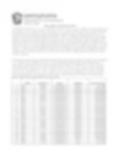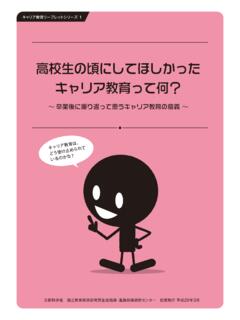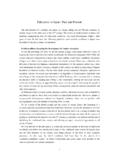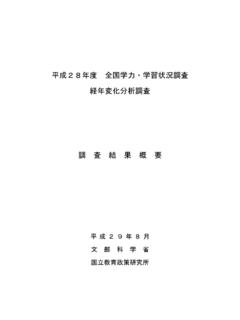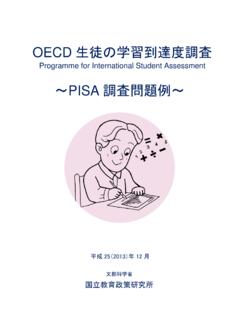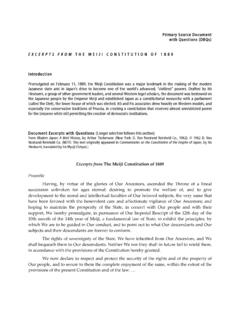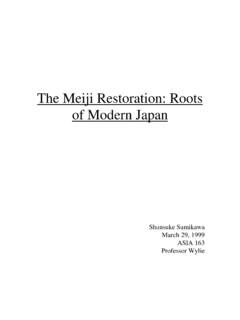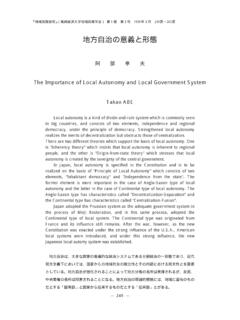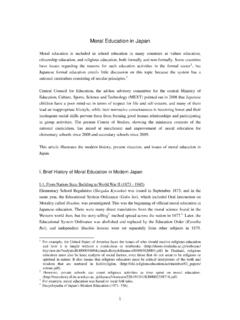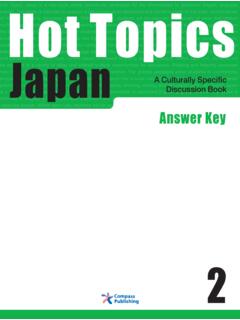Transcription of Primary Schools in Japan - NIER
1 Primary Schools in Japan Overview Japanese Primary school lasts for six years. In Japan , the school system is generally called the 6-3-3-4 year system, which expressly places Primary school education as the foundational stage of the entire school system. Although there are kindergartens for preschool education, these kindergartens do not form a part of the compulsory education system. Compared to the kindergarten enrollment rate of 60%, the Primary school enrollment rate exceeds 99%, proving Primary Schools to be the essential institutions responsible for the fundamental education of all Japanese citizens. The obligation to provide education and the right to receive education are stipulated in the constitution in Japan .
2 Accordingly, the school Education Act obligates Japanese citizens with children under their guardianship to enroll the children in Schools suitable to their educational stage for nine years. Among these nine years of compulsory education, the first six years fall under Primary school . For enrollment in Primary school , the age-grade system was adopted to enroll children according to their date of birth. Under this system, children enroll in Primary school as first-graders on the 1st of April, immediately following their 6th birthday. Also, under the principle of the age-grade system, children neither skip grades nor are they held back to repeat grades based on their academic performance.
3 Similarly, in principle, children who take a long leave due to sickness or some other reason almost always return to the grade suitable to their age. Primary Schools academic calendar begins in April and ends in March. The calendar is based on the five-day week system, and classes are held in a standard of 35 weeks a year (34 weeks in the case of first-graders). A period of 40 days beginning at the end of July and ending in early September forms the long recess called summer vacation. Winter vacation takes place for a span of two weeks from the end of December until the beginning of January, and two weeks of spring vacation begin in late March and end in early April.
4 A school year is divided into three terms spaced with these long recesses. In certain areas, flexible measures are taken to cope with circumstances specific to the regions, such as shorter summer vacation and longer winter vacation for Schools in cold regions, etc. While some national and private Primary Schools do exist, their respective numbers of 74 and 213 only represent and of the total number of Primary Schools in the country. Generally, Primary Schools are public Schools run by different municipalities. Most of the national Primary Schools are affiliated with the faculties of education in national universities. When a municipality has more than one school , school attendance areas are specified, allowing each resident to have only one school of choice.
5 In recent years, however, some localities allow their residents to choose from multiple Schools within the same municipality to enroll and study in. Some municipalities keep to the principle and forbid residents from practicing so-called cross-border enrollment, where pupils enroll and study in Schools outside the designated school districts, demonstrating different levels of flexibility on the matter between regions. Ordinary timetable of a day at Primary Schools is as follows: Arrival at school 8:00 8:30 Morning assembly for the whole school , homeroom, etc. 8:30 8:40 1st class 8:40 9:25 2nd class 9:30 10:15 Break 10:15 10:35 3rd class 10:35 11:20 4th class 11:25 12:20 school lunch 12:10 12:55 Lunch break* 12:55 13:15 5th class 13:35 14:20 6th class 14:25 15:10 End-of-the-day homeroom (for 5 classes)* 14:20 14:30 End-of-the-day homeroom (for 6 classes)* 15:10 15:20 Dismissal 15:30 * After the lunch break or the end-of-the-day homeroom (depends on the school ), pupils clean their classroom and/or common parts of school building.
6 In such a case, lower grade pupils (first and second grade) are supported by elder pupils. In most cases, a first-grader s school week consists of four days with five school hours and one day with four school hours, and for second-graders, every school day has five school hours. Generally, a third-grader s week has three days with five school -hours and two days with six school -hours, and fourth- to sixth-graders usually have two days with five school hours and three days with six school hours. The number of classes varies in accordance with the difference in total school hours laid out in the Course of Study. The above is just an example of an ordinary timetable; in reality, the schedules may vary depending on circumstances surrounding grades, classes, or due to special activities, etc.
7 Pupils usually spend their break time playing around in schoolyards, on the rooftops, etc. A classroom teacher is in charge of each classroom and, in principle, teaches all subjects. Team teaching, however, has been increasingly introduced these days in an attempt to lessen the teachers workload and to improve teaching. Also, specific subjects for upper grades, such as science, music, and home economics, are often led by specific subject-based teachers. All subject classifications, themes to be taught under each subject, numbers of school hours per subjects, etc., are provided in the Course of Study established by MEXT. The Course of Study has been updated approximately once a decade.
8 The present Course of Study, the eighth version since the Second World War, was initially introduced in Primary Schools in 2009 on a gradual basis and has been fully implemented since 2011 (details of the guideline will be described later in this paper). Pupils performances on subjects and record of day-to-day life are kept in the teaching-learning record (Shido-Yoroku) for each term. Most Schools compile a grade report card for each pupil including their academic performance, record of special activities and integrated studies, attendance record, observations of daily life, classroom teacher remarks, etc., and send it to their guardians once every term. An ordinary grade report card has spaces where the guardian affixes his or her seal of acknowledgement, and many such cards have columns for the guardian to write notices to the school .
9 Most Primary Schools provide school lunch. school lunches are either prepared at school lunch centers, where the lunches for several Schools are all prepared together and delivered to each school by trucks, etc., or at school lunch preparation room attached to individual Schools . Usually, pupils alternately take charge of serving meals. In most cases, pupils eat their lunch in their classrooms, while some Schools use spare classrooms as dining rooms where pupils from different grades dine together. school lunch is an integral part of school life as well as a part of the educational activities. Sometimes, traditional local specialties are also served as school lunch.
10 An ordinary school lunch menu consists of a staple food (bread, rice, or noodles), a main dish or soup, a drink (milk or fat-free milk), and a dessert. school lunch menus are supervised by nutrition teachers, and all children are served the same menu unless they have allergies or other special conditions. Although guardians are supposed to pay for the school lunch, some municipalities cover the entire cost as a countermeasure against the declining birth rate and population size. While it varies depending on grades or locality, the cost per meal ranges from approximately 200 yen to 280 yen. Textbooks for all subjects used at Primary Schools are provided free of charge.
